Accepted Scientific Name: Lithops schwantesii Dinter
Sudwestofr. Lithopsart. 14 (1928) Dinter
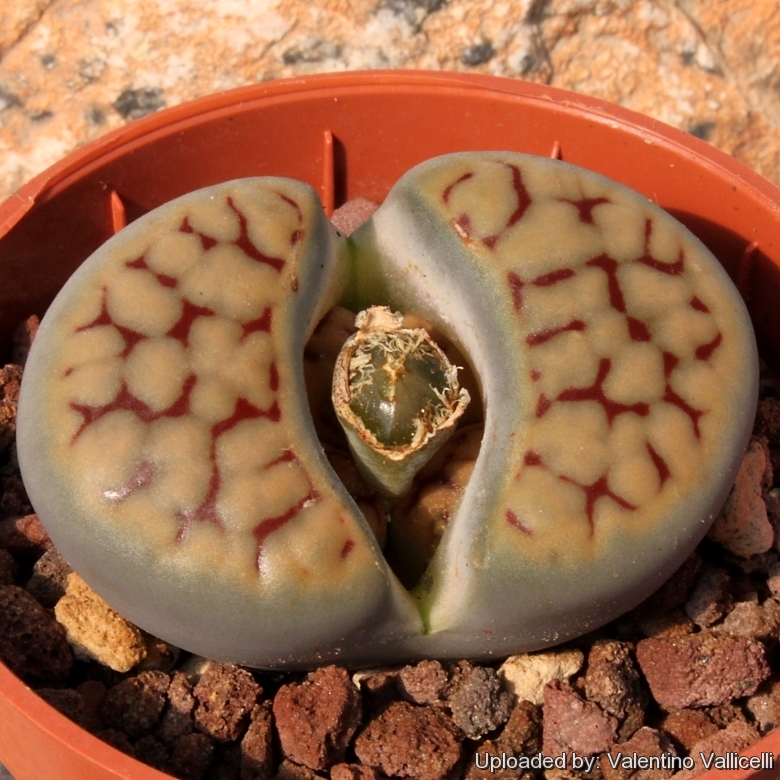
Lithops schwantesii var. triebneri Photo by: Valentino Vallicelli
(Locality Tiras) Orange-grey to mstardy stonelike tops! It is an heavy bloomer with lovely yellow flowers in autumn.
Origin and Habitat: Tirasberge, Namibia
Synonyms:
See all synonyms of Lithops schwantesii
back
Accepted name in llifle Database:Lithops schwantesii DinterSudwestofr. Lithopsart. 14 (1928)Synonymy: 49
- Lithops schwantesii Dinter
- Lithops gulielmi L. Bolus
- Lithops kuibisensis Dinter ex H.Jacobsen
- Lithops schwantesii C076 70 km W of Maltahöhe, Namibia
- Lithops schwantesii C077 Near Helmeringhausen, Namibia
- Lithops schwantesii C079 25 km SW of Helmeringhausen, Namibia
- Lithops schwantesii C080 30 km SW of Helmeringhausen, Namibia
- Lithops schwantesii C106 80 km W of Maltahöhe, Namibia
- Lithops schwantesii C143B 60 km NNE of Aus, Namibia
- Lithops schwantesii C144 (grey Form) 55 km NNE of Aus, Namibia
- Lithops schwantesii C145 55 km NE of Aus, Namibia
- Lithops schwantesii C146 55 km NE of Aus, Namibia
- Lithops schwantesii C150 (syn. kuibisensis) 25 km E of Aus, Namibia
- Lithops schwantesii C164 25 km SW of Helmeringhausen, Namibia
- Lithops schwantesii C184 (syn. gulielmi) TL: 10 km NW of Helmeringhausen, Namibia
- Lithops schwantesii C185 Near Helmeringhausen, Namibia
- Lithops schwantesii C190 70 km SW of Maltahöhe, Namibia
- Lithops schwantesii C191 60 km NW of Helmeringhausen, Namibia
- Lithops schwantesii C211 10 km SE of Helmeringhausen, Namibia
- Lithops schwantesii C250 (grey Form) 120 km SE of Aus, Namibia
- Lithops schwantesii C265 45 km N of Helmeringhausen, Namibia
- Lithops schwantesii var. marthae (Loesch & Tischer) D.T.Cole
- Lithops schwantesii var. marthae C148 60 km SSE of Aus, Namibia
- Lithops schwantesii var. marthae C249 TL: 60 km SSE of Aus, Namibia
- Lithops schwantesii var. marthae C299 120 km SSE of Aus, Namibia
- Lithops schwantesii var. marthae C411 75 km SE of Aus, Namibia
- Lithops schwantesii var. rugosa (Dinter) de Boer & Boom
- Lithops schwantesii var. rugosa C192 60 km NW of Helmeringhausen, Namibia
- Lithops schwantesii var. rugosa C247 TL: 40 km NW of Helmeringhausen, Namibia
- Lithops schwantesii var. triebneri (L. Bolus) de Boer & Boom
- Lithops schwantesii var. urikosensis (Dinter) de Boer & Boom
- Lithops schwantesii var. urikosensis C074 (syn. christinae) 50 km W of Maltahöhe, Namibia
- Lithops schwantesii var. urikosensis C075 (syn. nutupsdriftensis) TL: 35 km W of Maltahöhe, Namibia
- Lithops schwantesii var. urikosensis C083 Near Bethanien, Namibia
- Lithops schwantesii var. urikosensis C105 TL: 100 km NW of Maltahöhe, Namibia
- Lithops schwantesii var. urikosensis C107 (syn. christinae) 20 km W of Maltahöhe, Namibia
- Lithops schwantesii var. urikosensis C186 (syn. kunjasensis) 5 km NE of Helmeringhausen, Namibia
- Lithops schwantesii var. urikosensis C210 (syn. christinae) TL: 45 km W of Maltahöhe, Namibia
- Lithops schwantesii var. urikosensis C248 (syn. kunjasensis) 15 km NE of Helmeringhausen, Namibia
Accepted name in llifle Database:Lithops schwantesii subs. gebseri (de Boer) D.T.ColeLithops Flowering Stones 221 (1988)Synonymy: 3
back
Common Names include:
ENGLISH: Stone Plant, Flowering Stone
Description: Lithops triebneriSN|11518]]SN|11534]] is one of the innumerable local form of the very variable Lithops schwantesiiSN|11518]]SN|11518]]. It distinguishes for the presence of a top yellowish-brown or yellowish-brown with a distinct greenish tinge, with a varying number of isolated blood-red dots in the gentle depressions or a few dots connected by short blood-red lines, the dots remaining the dominant feature of the line. It has the same variable characteristics of the species and cultivated plants can be reliably distinguished from Lithops schwantesiiSN|11534]]SN|11518]] only when seeds or details of wild source are available.
Habit: It is a tiny caespitose succulent that grows almost completely buried in the soil with only the upper truncated portion of leaves visible. Bodies usually forming small groups with 1-3 heads (or more), up to 4 cm high. As with many other species, several varieties and local forms have been described based on the variation of the colour of the tops of the leaves.
Bodies (paired leaves): Truncate in profile, 20-40 mm long, 15-30 mm broad, top of lobe flat or slightly convex; colour of sides light grey; top yellowish-brown or yellowish-brown with a distinct greenish tinge, smooth or slightly rugulose with a varying number of isolated blood-red dots in the gentle depressions or a few dots connected by short blood-red lines, the dots remaining the dominant feature of the line; window opaque with a large number of round, dark-green miniature windows with a suffused bluish tinge; outer and inner margins a broad band more prominently buff-coloured than the rest of the top. Old leaves persist for one year usually, often for two years.
Flower: Yellow, often with longish pedicels, 20-36 mm in diameter.
Blooming season: Autumn.
Fruit: 5(-6) chambered, profile boat-shaped, top more or less flat, faces elliptic to broadly elliptic.
Subspecies, varieties, forms and cultivars of plants belonging to the Lithops schwantesii group
- Lithops gulielmi L. Bolus: top surface tight grey-white with many prominent blood-red dots or lines in the depressions, the dots forming the prominent feature, lines and dots isolated and not connected; window opaque. Dostribution: Klein Karasberge.
- Lithops kuibisensis Dinter ex H.Jacobsen: white-grey top and in the depressions purple-red dots or short lines and round these lines or dots a purplish border giving the whole top a suffused purplish tint. Distribution: Kuibis and adjacent areas. Namibia
 Lithops schwantesii Dinter: Windows and channels obscurely to pellucidly translucent grey-green, rubrications rarely absent, usually a prominent network of bold lines
Lithops schwantesii Dinter: Windows and channels obscurely to pellucidly translucent grey-green, rubrications rarely absent, usually a prominent network of bold lines- Lithops schwantesii C076 70 km W of Maltahöhe, Namibia: pinkish grey, mottled red lines.
 Lithops schwantesii C077 Near Helmeringhausen, Namibia: orange grey, pink tinge.
Lithops schwantesii C077 Near Helmeringhausen, Namibia: orange grey, pink tinge. Lithops schwantesii C079 25 km SW of Helmeringhausen, Namibia: orange grey, stonelike.
Lithops schwantesii C079 25 km SW of Helmeringhausen, Namibia: orange grey, stonelike. Lithops schwantesii C080 30 km SW of Helmeringhausen, Namibia: rusty pink, brilliant.
Lithops schwantesii C080 30 km SW of Helmeringhausen, Namibia: rusty pink, brilliant. Lithops schwantesii C106 80 km W of Maltahöhe, Namibia: transparent dots and lines.
Lithops schwantesii C106 80 km W of Maltahöhe, Namibia: transparent dots and lines.- Lithops schwantesii C143B 60 km NNE of Aus, Namibia: mustardy, with red streaks.
 Lithops schwantesii C144 (grey Form) 55 km NNE of Aus, Namibia: pinkish grey body, red lines.
Lithops schwantesii C144 (grey Form) 55 km NNE of Aus, Namibia: pinkish grey body, red lines.- Lithops schwantesii C145 55 km NE of Aus, Namibia: reddish grey, clear dots.
 Lithops schwantesii C146 55 km NE of Aus, Namibia: red dots and lines, grey body.
Lithops schwantesii C146 55 km NE of Aus, Namibia: red dots and lines, grey body. Lithops schwantesii C150 (syn. kuibisensis) 25 km E of Aus, Namibia: stone grey body, red lines.
Lithops schwantesii C150 (syn. kuibisensis) 25 km E of Aus, Namibia: stone grey body, red lines.- Lithops schwantesii C164 25 km SW of Helmeringhausen, Namibia: grey brown mottled top.
 Lithops schwantesii C184 (syn. gulielmi) TL: 10 km NW of Helmeringhausen, Namibia: orange brown top, red lines.
Lithops schwantesii C184 (syn. gulielmi) TL: 10 km NW of Helmeringhausen, Namibia: orange brown top, red lines.- Lithops schwantesii C185 Near Helmeringhausen, Namibia: pinkish grey, red lines.
 Lithops schwantesii C190 70 km SW of Maltahöhe, Namibia: salmon red, faint pattern.
Lithops schwantesii C190 70 km SW of Maltahöhe, Namibia: salmon red, faint pattern. Lithops schwantesii C191 60 km NW of Helmeringhausen, Namibia: soft pink stonelike top.
Lithops schwantesii C191 60 km NW of Helmeringhausen, Namibia: soft pink stonelike top.- Lithops schwantesii C211 10 km SE of Helmeringhausen, Namibia: puce pattern, stonelike.
 Lithops schwantesii C250 (grey Form) 120 km SE of Aus, Namibia: few red lines, dark grey body.
Lithops schwantesii C250 (grey Form) 120 km SE of Aus, Namibia: few red lines, dark grey body. Lithops schwantesii C265 45 km N of Helmeringhausen, Namibia: suffused with red-blue-grey.
Lithops schwantesii C265 45 km N of Helmeringhausen, Namibia: suffused with red-blue-grey.- Lithops schwantesii subs. gebseri (de Boer) D.T.Cole: Windows absent, channels reduced to a network of grooves or furrows, largely taken up by rubrications, faces opaque to very obscurely translucent shades of brown or brownish grey.
 Lithops schwantesii subs. gebseri C165 TL: 70 km S of Maltahöhe, Namibia: brainy texture.
Lithops schwantesii subs. gebseri C165 TL: 70 km S of Maltahöhe, Namibia: brainy texture. Lithops schwantesii var. marthae (Loesch & Tischer) D.T.Cole
Lithops schwantesii var. marthae (Loesch & Tischer) D.T.Cole- Lithops schwantesii var. marthae C148 60 km SSE of Aus, Namibia: grey pink, smooth.
- Lithops schwantesii var. marthae C249 TL: 60 km SSE of Aus, Namibia: tiny bodies, gemlike.
 Lithops schwantesii var. marthae C299 120 km SSE of Aus, Namibia: pinkish grey, red lines.
Lithops schwantesii var. marthae C299 120 km SSE of Aus, Namibia: pinkish grey, red lines.- Lithops schwantesii var. marthae C411 75 km SE of Aus, Namibia: pale tops with subtle markings.
 Lithops schwantesii var. rugosa (Dinter) de Boer & Boom
Lithops schwantesii var. rugosa (Dinter) de Boer & Boom- Lithops schwantesii var. rugosa C192 60 km NW of Helmeringhausen, Namibia: indented pink grooves.
- Lithops schwantesii var. rugosa C247 TL: 40 km NW of Helmeringhausen, Namibia
 Lithops schwantesii var. triebneri (L. Bolus) de Boer & Boom: Mustardy coloured tops. It is an heavy bloomer with yellow flowers in autumn.
Lithops schwantesii var. triebneri (L. Bolus) de Boer & Boom: Mustardy coloured tops. It is an heavy bloomer with yellow flowers in autumn.- Lithops schwantesii var. urikosensis (Dinter) de Boer & Boom
 Lithops schwantesii var. urikosensis C074 (syn. christinae) 50 km W of Maltahöhe, Namibia: grey top, red lines.
Lithops schwantesii var. urikosensis C074 (syn. christinae) 50 km W of Maltahöhe, Namibia: grey top, red lines. Lithops schwantesii var. urikosensis C075 (syn. nutupsdriftensis) TL: 35 km W of Maltahöhe, Namibia: Plant with very flat grey top and dark reddish lines.
Lithops schwantesii var. urikosensis C075 (syn. nutupsdriftensis) TL: 35 km W of Maltahöhe, Namibia: Plant with very flat grey top and dark reddish lines. Lithops schwantesii var. urikosensis C083 Near Bethanien, Namibia: light grey, red lines.
Lithops schwantesii var. urikosensis C083 Near Bethanien, Namibia: light grey, red lines. Lithops schwantesii var. urikosensis C105 TL: 100 km NW of Maltahöhe, Namibia: pink lines, grey body.
Lithops schwantesii var. urikosensis C105 TL: 100 km NW of Maltahöhe, Namibia: pink lines, grey body.- Lithops schwantesii var. urikosensis C107 (syn. christinae) 20 km W of Maltahöhe, Namibia: grey green,red lines.
- Lithops schwantesii var. urikosensis C186 (syn. kunjasensis) 5 km NE of Helmeringhausen, Namibia: grey with red lines.
 Lithops schwantesii var. urikosensis C210 (syn. christinae) TL: 45 km W of Maltahöhe, Namibia: grey top, dark lines.
Lithops schwantesii var. urikosensis C210 (syn. christinae) TL: 45 km W of Maltahöhe, Namibia: grey top, dark lines.- Lithops schwantesii var. urikosensis C248 (syn. kunjasensis) 15 km NE of Helmeringhausen, Namibia: gemlike pink-grey.
Notes: Lithops are partly subterranean, with only the clear 'window' in each leaf tip exposed above soil. A type of optical system exists whereby a layer of apical tissue rich in calcium oxalate crystals acts as a filter to intense sunlight before it reaches the thin chlorophyllous layer below. They are also called mimicry plants as they show a striking similarity to their background rocks and are difficult to detect when not in flower. These are the commonly known as pebble plants or living stones; each species is associated with one particular type of rock formation and occurs nowhere else. Its soil-embedded, subterranean growth form also reduces the need for chemical defences against herbivores.
Bibliography: Major refences and further lectures
1) Heidrun E. K. Hartmann (2002) “Aizoaceae F – Z” Springer
2) Achim Hecktheuer (2008) “Mesembs, mehr als nur Lithops” Books on Demand GmbH Norderstedt.
3) Desmond T. Cole & Naureen A. Cole, Uwe Beyer, Yves Delange (2008) “Les Lithops” SUCCULENTES Spécial 2008 AIAPS (now Terra seca).
4) Desmond T. Cole & Naureen A. Cole (2005) “LITHOPS Flowering Stones” Cactus & Co. Libri.
5) Yasuhiko Shimada (2001) “The Genus Lithops” Dobun Shoin. ISBN 4-8103-4066-X
6) Rudolf Heine (1986) “Lithops - Lebende Steine” Neumann Verlag.
7) Bernd Schlösser (2000) “Lithops – Lebende Steine” Praktische Anleitung für die Zimmerkultur. BussinessPoint MEDIA.
8) Steven A. Hammer (1999) “Lithops – Treasures of the veld” British Cactus and Succulent Society.
9) Desmond T. Cole (1988) “Lithops – Flowering Stones” Acorn Books CC.
10) Rudolf Heine (1986) “Lithops – lebende Steine” Neumann Verlag.
11) David L. Sprechman (1970) “Lithops” Associated University Presses, Inc.
12) Gert Cornelius Nel (1946) “Lithops” Hortors Limited, South Africa
13) G. C . Nel “Lithops: Plantae succulantae, rarissimae, in terra obscuratae, e famailia Aizoaceae, ex Africa australi” Hortors Limited, 78, Bree Street, Cape Town, South Africa 1946
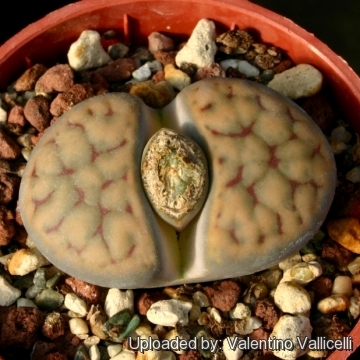 Lithops schwantesii var. triebneri Photo by: Valentino Vallicelli
Lithops schwantesii var. triebneri Photo by: Valentino Vallicelli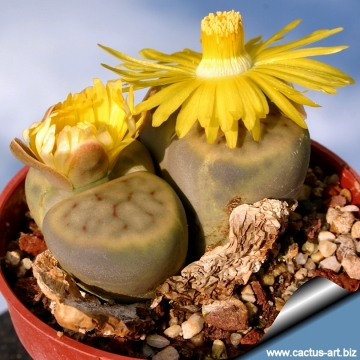 Lithops schwantesii var. triebneri Photo by: Cactus Art
Lithops schwantesii var. triebneri Photo by: Cactus Art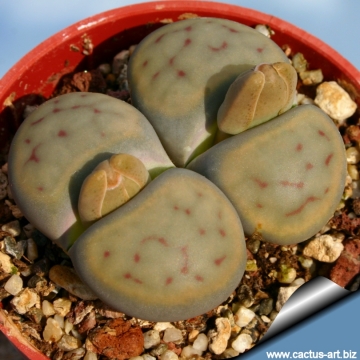 Lithops schwantesii var. triebneri Photo by: Cactus Art
Lithops schwantesii var. triebneri Photo by: Cactus Art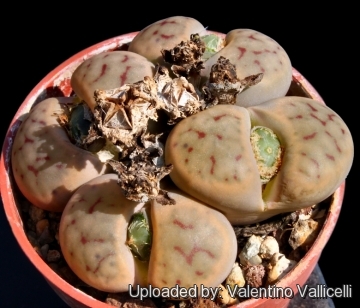 Lithops schwantesii var. triebneri Photo by: Valentino Vallicelli
Lithops schwantesii var. triebneri Photo by: Valentino Vallicelli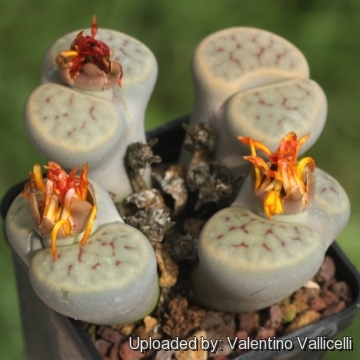 Lithops schwantesii var. triebneri Photo by: Valentino Vallicelli
Lithops schwantesii var. triebneri Photo by: Valentino VallicelliSend a photo of this plant.The gallery now contains thousands of pictures, however it is possible to do even more. We are, of course, seeking photos of species not yet shown in the gallery but not only that, we are also looking for better pictures than those already present.
Read More... Cultivation and Propagation: Need an open mineral, fast draining mix and the maximum amount of light you are able to give them. The basic cultivation routine is: Stop watering after flowering. Start watering after the old leaves completely dry. (Usually late March or Early April) Water freely during the growing season, soak the compost fully but allow it to dry out between waterings. Some growers fertilize frequently, some hardly ever. Keep them dry during the winter. Nearly all problems occur as a result of overwatering and poor ventilation especially when weather conditions are dull and cool or very humid.
Remarks: In the winter season the plant doesn’t need watering, but they will still be growing, the new bodies will be increasing in size as the old outer leaves begin to shrivel. In fact the plant in this time extracts water and nutrient stored in the outer succulent leaves, allowing them to dehydrate relocating the water to the rest of the plant and to the new leaves that form during this period until the old leaves are reduced to nothing more than "thin papery shells".















